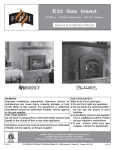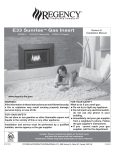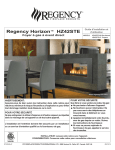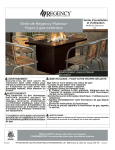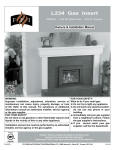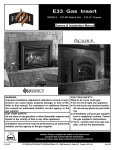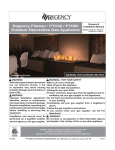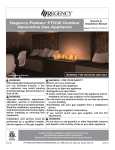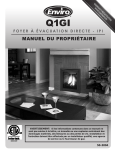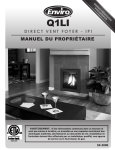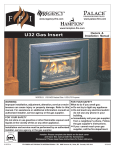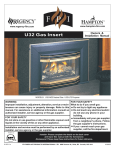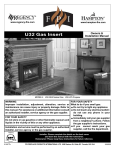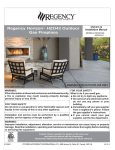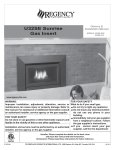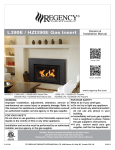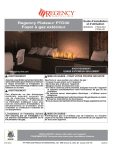Download Regency Fireplace Products E33-LP10 Installation manual
Transcript
E33 Gas Insert MODELS: E33-NG10 Natural Gas E33-LP10 Propane Owners & Installation Manual WARNING FIRE OR EXPLOSION HAZARD Failure to follow safety warnings exactly could result in serious injury, death, or property damage. - Do not store or use gasoline or other flammable vapors and liquids in the vicinity of this or any other appliance. - WHAT TO DO IF YOU SMELL GAS • Do not try to light any appliance. • Do not touch any electrical switch: do not use any phone in your building. Leave the building immediately. • Immediately call your gas supplier from a neighbour's phone. Follow the gas supplier's instructions. • If you cannot reach you gas supplier, call the fire department. - Installation and service must be performed by a qualified installer, service agency or the gas supplier. Tested by: 919-379 Installer: Please complete the details on the back cover and leave this manual with the homeowner. Homeowner: Please keep these instructions for future reference. REGENCY FIREPLACE PRODUCTS INTERNATIONAL LTD. 6988 Venture St., Delta, BC, Canada V4G 1H4 11.03.14 2| REGENCY GAS FIREPLACE INSERT TO THE NEW OWNER Congratulations! You are the owner of a state-of-the-art Gas Insert by Regency. The E33 Gas Insert has been designed to provide you with all the warmth and charm of a fireplace, at the flick of a switch. The E33-NG10 and E33-LP10 have been approved by Warnock Hersey/Intertek for both safety and efficiency. As it also bears our own mark, it promises to provide you with economy, comfort and security for many trouble free years to follow. Please take a moment now to acquaint yourself with these instructions and the many features of your Regency Fireplace. Energy E33 Video 2| E33-10 FPI Direct Vent Gas Insert dimensions | 3 32-1/4” 819mm 24-1/2” (622mm) optional spacer 1 3 4" (83mm) 3 1 " 4 (44mm) 1 11 16 (281mm) 3 22 4 " (578mm) 3 23 4 " (603mm) (729mm) 3 26 4 " (679mm) 11 28 16 " 1 46 2 " (1181mm) 7 42 16 " (1078mm) 1 16 4 " (413mm) Oversized Faceplate Dimensions" 49-9/16" x 33-1/8" H E33-10 FPI Direct Vent Gas Insert | 3 4| table of contents Dimensions.....................................................................3 Safety Decal...................................................................5 MA Code - CO Detector.................................................6 Important Message .......................................................7 For Your Safety...............................................................7 Before You Start.............................................................7 Gas Pressure Testing.....................................................8 Specifications.................................................................8 Installation Into A Solid Fuel Burning Fireplace Or Factory Built Fireplace...............................................8 Installation Checklist......................................................8 Materials Required.........................................................8 Gas Insert Aeration System............................................9 Minimum Fireplace Opening..........................................9 Minimum Clearances To Combustibles........................10 Combustible Mantel Clearances................................10 Gas Connection ........................................................... 11 Venting......................................................................... 11 Flue Liner Installation................................................... 11 Remote Receiver Installation.......................................12 Gas Pipe Pressure Testing...........................................12 SIT 829 Valve Description............................................12 DC Spark Igniter Battery Installation............................12 Optional Brick Panel.....................................................12 Log Set Installation.......................................................14 Conversion from NG to LP...........................................17 Low profile Faceplate Installation.................................18 Optional Backing Plate Installation...............................20 Safety Screen Installation.............................................21 Standard Flush Door....................................................21 Wiring Diagram.............................................................22 First Fire.......................................................................23 Operating Instructions..................................................23 Lighting Procedure.......................................................23 Shutdown Procedure....................................................23 DC Spark Igniter Battery Installation............................23 Copy of Lighting Instruction Plate.................................24 Automatic Convection Fan Operation..........................24 Normal Operating Sounds Of Gas Appliances.............24 Maintenance Instructions.............................................25 General Vent Maintenance...........................................25 Log Replacement.........................................................25 Glass Gasket................................................................25 Door Glass ..................................................................26 Fan Maintenance..........................................................26 Valve Assembly Removal And Installation....................27 Main Assembly.............................................................28 Burner & Log Assembly................................................29 Low profile faceplate ...................................................30 Warranty.......................................................................31 4| E33-10 FPI Direct Vent Gas Insert safety decal | 5 This is a copy of the labels that accompany each E33 Gas Insert. We have printed a copy of the contents here for your review. The safety label is located on a plate inside the base of the unit visible when the bottom louver is opened. Ensure that the safety label is attached to the unit. NOTE: Regency units are constantly being improved. Check the label on the unit and if there is a difference, the label on the unit is the correct one. 298 Duplicate Serial number DO NOT REMOVE THIS LABEL / NE PAS ENLEVER CETTE ETIQUETTE Listed: VENTED GAS FIREPLACE HEATER / FOYER AU GAZ À ÉVACUATION Certified for/Certifiée pour: CANADA and U.S.A. Certified to: CAN/CGA-2.17-M91(R2009) 298 Tested to: ANSI Z21.88-2014 & CSA 2.33-2014 4001172 Serial No. / No de serie NATURAL GAS FIREPLACE INSERT: MODEL E33-NG10 ÉQUIPÉ A L'UISINE POUR GAZ NATURAL Factory Equipped For Altitude 0-4500ft. (0-1370m) Model/Modele: E33-NG10 Min. Supply Pressure Low Setting Man. Pressure Max. Manifold Pressure Orifice Size Minimum Input Maximum Input 5“ 1.1" 3.8" 31 20,000 38,000 WC WC WC DMS Btu/h Btu/h Pression d'allimentation minimum Pression à la tubulure d'échappement basse Pression à la tubulure d'échappement élevée Dimensions de l'orifice (5.86 kW) Débit Calorifique minimum (11.13 kW) Débit Calorifique maximum (1.25 kpa) (0.27 kpa) (0.95 kpa) PROPANE GAS FIREPLACE INSERT: MODEL E33-LP10 ÉQUIPÉ A L'UISINE POUR GAZ PROPANE Factory Equipped For Altitude 0-4500ft. (0-1370m) Model/Modele: E33-LP10 Min. Supply Pressure Low Setting Man. Pressure Max. Manifold Pressure Orifice Size Minimum Input Maximum Input 12" 2.9" 11" 50 19,000 35,500 WC WC WC DMS Btu/h Btu/h (2.99 kpa) (0.72 kpa) (2.74 kpa) (5.56 kW) (10.4 kW) Mantel Clearances Alcove Width Alcove Depth E F 76" 36" (1930mm) (914mm) B D Non-Combustible Hearth Extension Hearth Height Hearth Width Hearth Depth G 1-1/4" H 45-1/2" I 13" C (32mm) (1156mm) (330mm) * Alcove side wall must have a min. of 8” clearance on one side. FPI Fireplace Products International Ltd., Delta BC, CANADA F A G I Pression d'allimentation minimum Pression à la tubulure d'échappement basse Pression à la tubulure d'échappement élevée Dimensions de l'orifice Débit Calorifique minimum Débit Calorifique maximum Fan Part No. 910-331/P ELECTRICAL SUPPLY/ALIMENTATION ELECTRIQUE: 115V60HZ less than/Moins de 2 AMP. NOT FOR USE WITH SOLID FUEL/ NE PAS UTILISER AVEC DU COMBUSTIBLE SOLIDE. H Minimum Clearances to Combustibles from Insert E Side Walls Ceiling Min. Mantel Height Max. Mantel Depth *A B C D 8" 47" 15" 3½" (203mm) (1194mm) (381mm) (89mm) MADE IN CANADA /FABRIQUE AU CANADA This appliance must be installed in accordance with local codes, if any; if none, follow the National Fuel Gas Code, ANSI Z223.1, or Natural Gas and Propane Installation Code, CSA B149.1. This appliance must be installed in accordance with the Standard CAN/CSA Z240 MH, Mobile Housing, in Canada, or with the Manufactured Home Construction and Safety Standard, Title 24 CFR, Part 3280, in the United States, or when such a standard is not applicable, ANSI/NCSBCS A225.1/NFPA 501A, Manufactured Home Installations Standard or ANSI A119.2 ou NFPA 501C Standard for Recreational Vehicles This appliance is only for use with the type of gas indicated on the rating plate and may be installed in an aftermarket, permanently located, manufactured (mobile) home where not prohibited by local codes. See owner's manual for details. WARNING: This fireplace has been converted for use with a gas fireplace insert only and cannot be used for burning wood or solid fuels unless all original parts have been replaced, and the fireplace re-approved by the authority having jurisdiction. Installer l'appareil selon les codes ou règlements locaux, ou, en l'absence de tels règlements, selon les codes d'installation ANSI Z223.1, National Fuel Gas Code ou CSA-B149.1 en vigueur. Installer l'appareil selon la norme CAN/CSA-Z240, Série MM, Maison mobiles ou CAN/CSA-Z240 VC, Véhicules de camping, ou la norme 24 CFR Part 3280, Manufactured Home Construction and Safety Standard. Si ces normes ne sont pas pertinentes, utilisez la norme ANSI/NCSBCS A225.1/NFPA 501A, Manufactured Home Installations Standard, ou ANSI A119.2 ou NFPA 501C Standard for Recreational Vehicles. Cet appareil doit être utilize uniquement avec le type de gaz indiqué sur la plaque signalétique. Cet appareil peut être installé dans une maison préfabriquée ou mobile (É.-U. seulement) installée à demeure si les règlements locaux le permettent. Voir la notice de l'utilisateur pour plus de renseignements. Cet appareil ne peut pas être utilisé avec d'autres gaz sauf si une trousse de conversion certifiée est fournie. AVERTISSEMENT: Ce foyer a été converti pour utilisation avec un foyer au gaz encastrable et ne peut être utiliser pour brûler du bois ou d'autres combustibles solides à moins que toutes les pièces d'origine aient été remplacées et que le foyer ait été approuvé de nouveau par l'autorité compétente. This vented gas fireplace heater is not for use with air filters. Ne pas utiliser de filtre à air avec ce foyer au gaz à évacuation. For use with glass doors certified with the appliance only Pour utilisation uniquement avec les portes en verre certifiées avec l'appareil For Use Only with Barrier (Part # 342-013) Follow installation instructions. Utiliser uniquement avec l’écran ( n ° 342-013) Suivre les instructions d'installation. VENTED GAS FIREPLACE HEATER - NOT FOR USE WITH SOLID FUELS. / FOYER AU GAZ À ÉVACUATION - NE PAS UTILISER AVEC DU COMBUSTIBLE SOLIDE. 919-378 E33-10 FPI Direct Vent Gas Insert | 5 6| requirements MA Code - CO Detector (for the State of Massachusetts only) 5.08: Modifications to NFPA-54, Chapter 10 (2) Revise 10.8.3 by adding the following additional requirements: (a) For all side wall horizontally vented gas fueled equipment installed in every dwelling, building or structure used in whole or in part for residential purposes, including those owned or operated by the Commonwealth and where the side wall exhaust vent termination is less than seven (7) feet above finished grade in the area of the venting, including but not limited to decks and porches, the following requirements shall be satisfied: 1. INSTALLATION OF CARBON MONOXIDE DETECTORS. At the time of installation of the side wall horizontal vented gas fueled equipment, the installing plumber or gasfitter shall observe that a hard wired carbon monoxide detector with an alarm and battery back-up is installed on the floor level where the gas equipment is to be installed. In addition, the installing plumber or gasfitter shall observe that a battery operated or hard wired carbon monoxide detector with an alarm is installed on each additional level of the dwelling, building or structure served by the side wall horizontal vented gas fueled equipment. It shall be the responsibility of the property owner to secure the services of qualified licensed professionals for the installation of hard wired carbon monoxide detectors a. In the event that the side wall horizontally vented gas fueled equipment is installed in a crawl space or an attic, the hard wired carbon monoxide detector with alarm and battery back-up may be installed on the next adjacent floor level. b. In the event that the requirements of this subdivision can not be met at the time of completion of installation, the owner shall have a period of thirty (30) days to comply with the above requirements; provided, however, that during said thirty (30) day period, a battery operated carbon monoxide detector with an alarm shall be installed. 2. APPROVED CARBON MONOXIDE DETECTORS. Each carbon monoxide detector as required in accordance with the above provisions shall comply with NFPA 720 and be ANSI/UL 2034 listed and IAS certified. 3. SIGNAGE. A metal or plastic identification plate shall be permanently mounted to the exterior of the building at a minimum height of eight (8) feet above grade directly in line with the exhaust vent terminal for the horizontally vented gas fueled heating appliance or equipment. The sign shall read, in print size no less than one-half (1/2) inch in size, "GAS VENT DIRECTLY BELOW. KEEP CLEAR OF ALL OBSTRUCTIONS". 4. INSPECTION. The state or local gas inspector of the side wall horizontally vented gas fueled equipment shall not approve the installation unless, upon inspection, the inspector observes carbon monoxide detectors and signage installed in accordance with the provisions of 248 CMR 5.08(2)(a)1 through 4. (b) EXEMPTIONS: The following equipment is exempt from 248 CMR 5.08(2)(a)1 through 4: 1. The equipment listed in Chapter 10 entitled "Equipment Not Required To Be Vented" in the most current edition of NFPA 54 as adopted by the Board; and 2. Product Approved side wall horizontally vented gas fueled equipment installed in a room or structure separate from the dwelling, building or structure used in whole or in part for residential purposes. (c) MANUFACTURER REQUIREMENTS - GAS EQUIPMENT VENTING SYSTEM PROVIDED. When the manufacturer of Product Approved side wall horizontally vented gas equipment provides a venting system design or venting system components with the equipment, the instructions provided by the manufacturer for installation of the equipment and the venting system shall include: 1. Detailed instructions for the installation of the venting system design or the venting system components; and 2. A complete parts list for the venting system design or venting system. (d) MANUFACTURER REQUIREMENTS - GAS EQUIPMENT VENTING SYSTEM NOT PROVIDED. When the manufacturer of a Product Approved side wall horizontally vented gas fueled equipment does not provide the parts for venting the flue gases, but identifies "special venting systems", the following requirements shall be satisfied by the manufacturer: 1. The referenced "special venting system" instructions shall be included with the appliance or equipment installation instructions; and 2. The "special venting systems" shall be Product Approved by the Board, and the instructions for that system shall include a parts list and detailed installation instructions. (e) A copy of all installation instructions for all Product Approved side wall horizontally vented gas fueled equipment, all venting instructions, all parts lists for venting instructions, and/or all venting design instructions shall remain with the appliance or equipmentat the completion of the installation. 6| E33-10 FPI Direct Vent Gas Insert installation IMPORTANT MESSAGE SAVE THESE INSTRUCTIONS The Regency Gas Insert must be installed in accordance with these instructions. Carefully read all the instructions in this manual first. Consult the building authority having jurisdiction to determine the need for a permit prior to starting the installation. NOTE: Failure to follow the instructions could cause a malfunction of the heater which could result in death, serious bodily injury, and/or property damage. Failure to follow these instructions may also void your fire insurance and/or warranty. FOR YOUR SAFETY This appliance requires air for proper combustion. Always provide adequate combustion and ventilation air. Follow instructions and information in CAN/CGA B149 (in Canada) or the National Fuel Gas Code ANSI Z223.1 (in the USA), regarding requirements for combustion and ventilation air. INSTALLATION AND REPAIR SHOULD BE DONE BY AN AUTHORIZED SERVICE PERSON. THE APPLIANCE SHOULD BE INSPECTED BEFORE USE AND AT LEAST ANNUALLY BY A PROFESSIONAL SERVICE PERSON. MORE FREQUENT CLEANING MAY BE REQUIRED DUE TO EXCESSIVE LINT FROM CARPETING, BEDDING MATERIAL, ETC. IT IS IMPERATIVETHAT CONTROL COMPARTMENTS, BURNERS AND CIRCULATING AIR PASSAGEWAYS OF THE APPLIANCE BE KEPT CLEAN. DUE TO HIGH TEMPERATURES, THE APPLIANCE SHOULD BE LOCATED OUT OF TRAFFIC AND AWAY FROM FURNITURE AND DRAPERIES. WARNING: FAILURE TO INSTALL THIS APPLIANCE CORRECTLY WILL VOID YOUR WARRANTY AND MAY CAUSE A SERIOUS HOUSE FIRE. CHILDREN AND ADULTS SHOULD BE ALERTED TO THE HAZARDS OF HIGH SURFACE TEMPERATURES, ESPECIALLY THE FIREPLACE GLASS, AND SHOULD STAY AWAY TO AVOID BURNS OR CLOTHING IGNITION. YOUNG CHILDREN SHOULD BE CAREFULLY SUPERVISED WHEN THEY ARE IN THE SAME AREA AS THE APPLIANCE. TODDLERS, YOUNG CHILDREN AND OTHERS MAY BE SUSCEPTIBLE TO ACCIDENTAL CONTACT BURNS. A PHYSICAL BARRIERS IS RECOMMENDED IF THERE ARE AT RISK INDIVIDUAL IN THE HOUSE. TO RESTRICT ACCESS TO A FIREPLACE OR STOVE, INSTALL AN ADJUSTABLE SAFETY GATE TO KEEP TODDLERS, YOUNG CHILDREN AND OTHER AT RISK INDIVIDUALS OUT OF THE ROOM AND AWAY FROM HOT SURFACES. CLOTHING OR OTHER FLAMMABLE MATERIAL SHOULD NOT BE PLACED ON OR NEAR THE APPLIANCE. A BARRIER DESIGNED TO REDUCE THE RISK OF BURNS FROM THE HOT VIEWING GLASS IS PROVIDED WITH THIS APPLIANCE AND SHALL BE INSTALLED FOR THE PROTECTION OF CHILDREN AND OTHER AT-RISK INDIVIDUALS IF THE BARRIER BECOMES DAMAGED, THE BARRIER SHALL BE REPLACED WITH THE MANUFACTURER'S BARRIER FOR THIS APPLIANCE. ANY SAFETY SCREEN, GUARD, OR BARRIER REMOVED FOR SERVICING AN APPLIANCE MUST BE REPLACED PRIORTO OPERATINGTHE APPLIANCE. BEFORE YOU START Safe installation and operation of this appliance requires common sense, however, we are required by the Canadian Safety Standards and ANSI Standards to make you aware of the following: General Safety Information 1) The appliance installation must conform with local codes or in the absence of local codes, with CAN/CGA B149 (in Canada) or the National | 7 Fuel Gas Code ANSI Z223.1 in the U.S.A. This appliance should be installed by a qualified gas fitter technician only. 2) Installation and repair should be done by a qualified service person. 3) The appliance should be inspected before use and at least annually by a professional service person. More frequent cleaning may be required due to excessive lint from carpeting, bedding material, animal hair, etc. It is imperative that control compartments, burners and circulating air passageways of the appliance be kept clean. 4) See general construction and assembly instructions. This appliance may only be installed in a vented, noncombustible fireplace. 5) This appliance is Listed for bedroom installations when used with a Listed Millivolt Thermostat. Some areas may have further requirements, check local codes before installation. 6) Always connect this insert to a vent system venting to the outside of the building envelope. Never vent to another room or inside a building. Make sure that the vent is properly sized and is of adequate height to provide the proper draft. 7) Inspect the venting system annually for blockage and any signs of deterioration. 8) Any glass removed for servicing must be replaced prior to operating the appliance. 9) To prevent injury, do not allow anyone who is unfamiliar with the operation to use the fireplace. 10)Due to high temperatures, the appliance should be located out of high traffic areas and away from furniture and draperies. Children and adults should be alerted to the hazards of high surface temperatures, especially the fireplace glass and gold trims, and should stay away to avoid burns or clothing ignition. Young children should be carefully supervised when they are in the same room as the appliance. Clothing or other flammable material should not be placed on or near the appliance. Emissions from burning wood or gas could contain chemicals known to the State of California to cause cancer, birth defects or other reproductive harm. For the State of Massachusetts, installation and repair must be done by a plumber or gasfitter licensed in the Commonwealth of Massachusetts. For the State of Massachusetts, flexible connectors shall not exceed 36 inches in length. For the State of Massachusetts, the appliances individual manual shut-off must be a t-handle type valve. The State of Massachusetts requires the installation of a carbon monoxide alarm in accordance with NFPA 720 and a CO alarm with battery back up in the same room where the gas appliance is installed. E33-10 FPI Direct Vent Gas Insert | 7 8| installation GAS PRESSURE TESTING The appliance must be isolated from the gas supply piping system by closing its individual manual shut off valve during any pressure testing of the gas supply piping system at test pressures equal to or less than 1/2 psig. (3.45 kPa). SPECIFICATIONS At pressures over 1/2 psig, the pipe to the unit must be disconnected. Gas Input Capacity: Natural Gas 38,000 Btu/h Propane 35,500 Btu/h Min. Input: Natural Gas 20,000 Btu/h Propane 19,000 Btu/h Fuels: Approved for use with both natural gas, and propane. Approved as is for use at 0' to 4,500' (0-1370m). Electrical: 120V A.C. system. Circulation Fan: Variable speed, 127 CFM. Log Set: Ceramic fibre, 8 per set. Vent System: 3" co-linear aluminum flex. INSTALLATION INTO A SOLID FUEL BURNING FIREPLACE OR FACTORY BUILT FIREPLACE The E33 Gas Inserts have been tested and approved to be vented into any masonry fireplace or approved solid fuel burning factory built fireplace that will allow the insert to physically fit into the firebox. Refer to the "Minimum Fireplace Dimensions" section. If the factory built fireplace* height is too low for your Insert, you may remove the smoke baffle plate and damper from the factory built fireplace as long as these items are saved and are reinstalled in the event that the Insert is removed. NOTE: Any alterations made to the listed solid fuel burning factory built fireplace may void the listing of the fireplace. Cutting any sheet-metal parts of the fireplace, in which the gas fireplace insert is to be installed, is prohibited. If the factory-built fireplace has no gas access hole(s) provided, an access hole of 1.5" (37.5mm) or less may be drilled through the lower sides or bottom of the firebox in a proper workmanship like manner. This access hole must be plugged with non-combustible 8| E33-10 FPI Direct Vent Gas Insert insulation after the gas supply line has been installed. The fireplace and fireplace chimney must be clean and in good working order and constructed of non-combustible materials and chimney cleanouts must fit properly. Refractory, glass doors, screen rails, screen mesh, and log grates can be removed from the fireplace before installing the gas fireplace insert. Smoke shelves, shields and baffles may be removed if attached by mechanical fasteners. A tight connection between the gas fireplace insert flue collar and the fireplace chimney must be made. *Check with your local inspector before commencing with this installation. "WARNING: This fireplace has been converted for use with a gas fireplace insert only and cannot be used for burning wood or solid fuels unless all original parts have been replaced, and the fireplace re-approved by the authority having jurisdiction." 9) Install standard and optional features. Refer to the following sections where applicable: a. Brick Panels b. Log Installation c. Faceplate d. Standard Flush Door e. Remote Control 10)Final check. Refer to the "Final Check" section. Before leaving this unit with the customer, the installer must ensure that the appliance is firing correctly. This includes: INSTALLATION CHECKLIST Before installing vent system ensure that the damper plate is open and secure to prevent the damper plate from falling down and crushing the liner. The Regency Gas Insert is installed as listed below. a) Clocking the appliance to ensure the correct firing rate. b) Adjusting the primary air, if required, to ensure that the flame does not carbon. Refer to the "Gas Insert Aeration System" section. c) Ensuring that the appliance is venting correctly. 1) Check all clearances to combustibles. Refer to the following sections where applicable: a. Minimum Clearances to Combustibles. b. Regency Flush Combustible Mantel Clearances c. Mantel Clearances 2) Make the gas connection. Refer to the "Gas Connection" section. MATERIALS REQUIRED 6) Slide the unit fully into the fireplace. No electrical power supply is required for the gas control to operate. A 120 Volt AC power cord is hooked up to the fan. Plug the 3 wire cord into a suitable receptacle. Do not cut the ground terminal off under any circumstances. When connected with 120 volts, the appliance must be electrically grounded in accordance with local codes, current version of the Canadian Electrical Code CSA C22.1 (in Canada) or in the absence of local codes, with the National Electrical Code ANSI/NFPA 70. 7) Install 4AA batteries into receiver. Hook receiver to wire marked receiver, this will enable operation of the appliance manually when position in "ON" position. NOTE: This unit is equipped with a heat sensor thermodisc which will prevent the blower from operating until the unit reaches the correct temperature. 3) Install the 3" flue liner to the sliding connector plate. Refer to the "Flue Liner Installation" section. 4) Slide the unit half way into the fireplace. 5) Pull the vent connector plate through the tapered brackets and fasten to the front plate. Refer to the "Flue Liner Installation" section. 8) Test gas pressure, refer to the "Gas Pipe Pressure Testing" section. Check aeration system, refer to "Gas Insert Aeration Systems" section. Installer must mechanically attach the supplied label to the inside of the firebox of the fireplace into which the gas fireplace insert is installed. installation MINIMUM FIREPLACE OPENING The air shutter can be adjusted by moving the adjusting wire up or down. The wire is accessed through the bottom louver opening. Open the air shutter for a blue flame or close for a yellower flame. The burner aeration is factory set but may need adjusting due to either the local gas supply or altitude. The minimum fireplace opening for the Regency gas fireplace insert when using the supplied spacer is shown in the following diagrams: Minimum Air Shutter Opening: 5/16" Natural Gas 7/16" Propane 9 18" (457mm) GAS INSERT AERATION SYSTEM | 35-1/4" (895mm) Note: Any damage due to carboning resulting from improperly setting the aeration controls is NOT covered under warranty. Note: Aeration Adjustment should only be performed by an authorized Regency Installer at the time of installation. 25-1/2" (648mm) CAUTION: Carbon will be produced if air shutter is closed too much. 9-1/4" (235mm) 18" (457mm) MINIMUM FIREPLACE OPENING (LOW PROFILE FACEPLATE AND SPACER) The minimum fireplace opening for the Regency gas fireplace insert is shown in the following diagrams: 7-1/8” (200mm) Low profile E33-10 FPI Direct Vent Gas Insert | 9 10 | installation MINIMUM CLEARANCES TO COMBUSTIBLES From Unit Side Walls * A 8" (203 mm) Ceiling B 47" (1194 mm) Min. Mantel Height C 15" (381 mm) Max. Mantel Depth D 12" (305 mm) Alcove Width Alcove Depth E 76" (1930 mm) F 36" (914 mm) Hearth Height Hearth Width Hearth Depth G 1-1/4" (32 mm) H 45-1/2" (1156 mm) I 13" (330 mm) * Alcove side wall must have a min. of 8" clearance on one side. COMBUSTIBLE MANTEL CLEARANCES Because of the extreme heat this fireplace emits, the mantel clearances are critical. Note: A non-combustible mantel may be installed at a lower height if the framing is made of metal studs covered with a noncombustible board. Mantel can be installed anywhere in shaded area or higher using the above scale. Note: Ensure the paint that is used on the mantel and the facing is "heat resistant" or the paint may discolour. 10| E33-10 FPI Direct Vent Gas Insert installation GAS CONNECTION GAS CONNECTION WARNING: Only persons licensed to work with gas piping may make the necessary gas connections to this appliance. 1) If the appliance is to be installed into an existing chimney system, thoroughly clean the masonry or factory built fireplace. 2) The appliance is provided with an opening on the left hand side of the control compartment. A 3/8" NPT gas supply pipe must be brought near this inlet hole. | 11 In areas of consistently high winds, we recommend using the Simpson Dura-Vent System (46dva-GK adapter and 46dva-VCH high-wind cap). The Air Intake pipe must be attached to the inlet air collar of the termination cap. FLUE LINER INSTALLATION 1) Cut the flex liner as required. 2) Mark the end of one liner with an "E" to indicate Exhaust. 3) Connect the other end of the above liner to the exhaust side of the termination adaptor, seal connection with high temperature silicone. Secure with 3 screws. 4) Connect the 2nd liner to the inlet side of the adaptor, seal connection with high temperature silicone. Secure with 3 screws. 5) Install flashing. 6) Insert both liners into chimney, passing through the damper opening. 7) Install termination cap. 8) Remvoe vent connector plate by removing screw located on top/front of appliance. 9) Connect the marked end of the liner to the exhaust collar of the vent connector plate marked with an "E", seal connection with high temperature silicone. Secure with 3 screws. 3) Locate the center point where the vent will pass through the chimney above the appliance. Move the appliance into the exact location where it is to be installed. Ensure that the Insert is level. THE APPLIANCE MUST NOT BE CONNECTED TO A CHIMNEY FLUE SERVING A SEPARATE SOLID FUEL BURNING APPLIANCE. VENTING This appliance is designed to be attached to two 3" (76mm) co-linear aluminium flex running the full length of the chimney. The flue length must be a minimum length of 8 ' (2.44m) and a maximum of 35' (10.7m). See chart above for minimum distances from roof. Periodically check that the vent is unrestricted. 10)Connect the 2nd liner to the intake collar, seal connection with high temperature silicone. 11)Align vent connector plate with guides on unit. 12)Slide unit into masonry opening, while ensuring that the slot at the rear of the connector plate mates up with the hold down plate on the unit. 13) Secure with Screw–removed from Step 8. Secure with 3 screws. NOTE: 1) Final gas connection should be made after unit is in place to avoid damage to line when pushing the unit into position. 2) Mill-pac may be used instead of high tempture silicone and screws may be used instead of gear clamps at connections of liner to inlet and vent collars. Masonry chimneys may take various contours which the flexible liner will accommodate. However, keep the flexible liner as straight as possible, avoid unnecessary bending. Part # 948-305 946-529 Description 3" Flex - 35 ft. Regency Co-linear DV Vertical Termination Cap Alternate Approved Caps 46dva-VC Vertical Termination Cap 46dva-VCH High Wind Cap 46dva-GK 3" Co-linear Adaptor with flashing E33-10 FPI Direct Vent Gas Insert | 11 12 | installation REMOTE RECEIVER INSTALLATION 1) Install the heat shield to the receiver with two screws. DC SPARK IGNITER BATTERY INSTALLATION Install the supplied battery into the DC Sparker Box by opening the battery compartment. NOTE: The battery in the DC Sparker Box will need to be replaced annually. 2) Attach to the floor of the unit with a velcro pad. Locate the receiver at the far right hand side of unit as shown below. 3) See Remote Control installation instructions for information on coding the handheld transmitter to the receiver GAS PIPE PRESSURE TESTING The appliance must be isolated from the gas supply piping system by closing its individual manual shutoff valve during any pressure testing of the gas supply piping system at test pressures equal to or less than 1/2 psig. (3.45 kPa). Disconnect piping from valve at pressures over 1/2 psig. The manifold pressure is controlled by a regulator built into the gas control, and should be checked at the pressure test point. NOTE: To properly check gas pressure, both inlet and manifold pressures should be checked using the valve pressure ports on the valve. 1) Make sure the valve is in the "OFF" position. 2) Loosen the "IN" and/or "OUT" pressure tap(s), turning counterclockwise with a 1/8" wide flat screwdriver. 3) Attach manometer to "IN" and/or "OUT" pressure tap(s) using a 5/16" ID hose. 4) Light the pilot and turn the valve to "ON" position. 5) The pressure check should be carried out with the unit burning and the setting should be within the limits specified on the safety label. 6) When finished reading manometer, turn off the gas valve, disconnect the hose and tighten the screw (clockwise) with a 1/8" flat screwdriver. Note: Screw should be snug, but do not over tighten. 12| E33-10 FPI Direct Vent Gas Insert OPTIONAL BRICK PANEL SIT 829 VALVE DESCRIPTION Optional Brick Panel Set: 1) 2) 3) 4) 5) 6) 7) 8) 9) Part # 340-043 340-094 511-031 Gas on/off knob Electronically Operated Hi/Lo Pilot Adjustment Thermocouple Connection - option Outlet Pressure Tap Inlet Pressure Tap Pilot Outlet Main Gas Outlet Alternative TC Connection Point Description Top (brick) panel Back (brick) panel Left (brick) panel Right (brick)panel Top bracket Bottom clips Brick clips Qty 1 1 1 1 1 2 2 installation BRICK PANEL INSTALLATION 1) Remove safety screen and glass door if installed. 6) Slide the top panel and bracket assembly carefully onto the baffle plate ensuring the panel is centered. Make sure the tabs of the top bracket fit into the baffle openings (refer to Diagram 3). 2) Remove the logs if they are already installed. Note: the grate must be removed in order to remove the bottom log. Ensure you slide the bottom coal off to the right-hand side to avoid chipping. | 13 9) Insert the side panel by positioning it flat against the side walls. Tilt the panel towards the middle of the firebox, then insert the bottom front corner. Repeat on the other side. 10)Install the 2 brick retaining clips, one on each side. 3) Unwrap the brick pattern panels from the protective wrapping. Handle the panels with care as they can break easily. 4) Remove the two screws from the bottom of the baffle plate. Install the bottom clips onto the baffle plate (refer to Diagram 1). Diagram 3 7) Insert the back panel by sliding it between the sidewalls of the firebox and the rear log support. Bottom Clips 8) Before installing the side brick panels, remove the screws from the side brick clips (refer to Diagram 4). Diagram 1 5) Place the top bracket onto the top edge of the top panel (refer to Diagram 2). Completed Installation Top Bracket Diagram 4 Diagram 2 E33-10 FPI Direct Vent Gas Insert | 13 DIRECT VENT FIREPLACE 14 | installation LOG SET INSTALLATION E33 LOG INSTALLATION WARNING: Dangerous operating conditions may occur if these logs are not positioned in their correct certified locations. Read the following instructions carefully and refer to the attached diagrams. 3) Remove the grate by removing the two Phillips screws. Slide the grate outwards to remove it from the unit (refer to Diagram 1). Gas Log Kit #340-930 contains the following: 03-17 03-18 03-19 03-20 03-21 03-22 03-23 03-24 946-669 Bottom Log Center Top Log Front Log Left Log Right Log Left top Log Rear Log Right Top Log Platinum Embers (supplied in packaged manual) 03-23 03-22 Diagram 1 4) Angle log 03-17 and slide it between the top and bottom burner tube under the "T" section until it touches the left grate support bracket (refer to Diagram 2). 03-24 03-18 03-17 03-20 03-19 03-21 03-17 The "03" reference numbers (i.e. 03-23) are molded into the rear of each log. 1) Remove and carefully unwrap the logs from the box. Please handle with care and do not force them into position to avoid chipping. Diagram 2 5) Re-install the grate. 6) Line up the pin holes (located at the bottom of log 03-23) to the pins of the rear log support and position them into place. (refer to Diagram 3) 03-23 2) Remove the safety screen and glass door if already installed. Locating Pins Diagram 3 918-416a 14| E33-10 FPI Direct Vent Gas Insert Page 1 of 3 12/18/07 DIRECT VENT FIREPLACE E33 | installation 7) Align the bottom grooves of log 03-21 onto the right side of the grate and gently slide the log back until it touches the locating tab (refer to Diagram 4 & 5). 15 03-23 03-21 03-21 03-17 Locating Tab Diagram 7 9) Place log 03-22 over log 03-23 and log 03-20. Ensure the pin hole of log 03-22 lines up with the left pin of log 03-23 as well as the left pin of log 03-20 (refer to Diagram 8). Diagram 4 03-23 03-22 03-23 03-20 Locating Pins 03-20 03-21 03-17 Diagram 8 Diagram 5 8) Align and position the pin hole of log 03-20 down into the left locating pin of log 03-21. Slide into the groove and gently place into position until it touches the locating tab. (see Diagram 6 & 7) 10) Place log 03-18 over log 03-23 and log 03-20. Ensure the pin hole of log 03-18 lines up with the middle pin of log 03-23 and the right pin of log 03-20 (refer to Diagram 9 & 10). 03-23 03-18 03-20 Locating Pin Locating Tab Locating Pins 03-21 Diagram 6 918-416a 03-20 Diagram 9 Page 2 of 3 11.05.14 E33-10 FPI Direct Vent Gas Insert | 15 DIRECT VENT FIREPLACE 16 | installation E33 12) Place log 03-19 over the left center of the grate. Ensure the log set looks like Diagram 12. 03-23 03-18 03-22 03-20 03-17 Diagram 10 03-19 11) Place log 03-24 over log 03-23 and log 03-21 ensuring the pin hole of log 03-24 lines up with the right pin of log 03-23 and the right pin of log 03-21 (refer to Diagram 11). Diagram 12 13) Separate platinum embers and place at the front of the burner. Avoid stacking platinum embers. 03-24 03-23 Locating Pins 03-21 Diagram 11 918-416a 16| E33-10 FPI Direct Vent Gas Insert Page 3 of 3 11.05.14 E33-10 | 17 installation ConversionfromNGtoLP CONVERSION KIT 342-969 FROM NG TO LP forE33-10usingSIT829NOVAGasValve for E33-10 using SIT 829 NOVA Gas Valve THIS CONVERSION MUST BE DONE BY A QUALIFIED GAS FITTER IF IN DOUBT DO NOT DO THIS CONVERSION !! THIS CONVERSION MUST BE DONE BY A QUALIFIED GAS FITTER IF IN DOUBT DO NOT DO THIS CONVERSION !! Each Kit contains one LP Conversion Kit Contains: Qty. 1 1 1 Part # 904-529 904-641 918-590 1 1 1 1 908-528 910-037 910-582 919-453 Description 5/32" Allen Key BurnerOrifice#50 Label "Converted to LPG" Red LPG Label LPInjector (PilotOrifice) Stepper Motor InstructionSheet Installation of LP Conversion Kit: 1. Shutoffthegassupply. 2. Removesafetyscreenandglassdoor. 7. Unscrewthepilotorificewiththe5/32" allenkeyandreplacewiththeLPGpilot orificeprovidedinthekit,thenreinstall thepilotcap. 11.Checkforgasleakswithapropersoapy solutionorleakdetector. 12.Checkforpropersparkbetweenthe ignitorandpilotcap.Referto"Lighting Procedure"sectionofthemanualforlightingsequence. 13.Checkpilotflames.Correctflamepattern has3strongblueflames.Adjustmentcan bemadebyturningtheslottedscrewat thetoprightcornerofthevalve.Referto "MaintenanceInstructions"sectionofthe manualforcorrectflamepatterns. 8. Removeburnerorificewitha1/2"wrench, whileusinga9/16"wrenchtoholdonto theelbowbehindtheorificeanddiscard orifice. 3. Removethelogsandgrate(referLog InstallationsectioninE33Manual). Ensureyouslidethebottomlog03-17off totheright-handsidetoavoidchipping. 14.Checkinlet(11"WCmin)andoutlet(10" WC)pressures.Referto"GasPipePressureTesting"sectionofthemanual. 15.ReverseSteps5to3. 16.Attachthelabel"ThisunithasbeenconvertedtoLP"nearorontopoftheserial# decal. 17.Replaceyellow"NG"labelwithred"LP" label. 18.Checkoperationofflamecontrol. 4. Removefrontbasebrick. 19.Checkforproperflameappearanceand glowonlogs. Burner Orifice Removal 9. ReinstallnewburnerorificeLPstamped #50andtighten. Installer Notice: These instructions must be left with the appliance. 10.RemoveNGsteppermotorbyremoving3 screwsinlocationsshownbelow–replace withLPsteppermotor,secureinplace with3screws. 5. Removeburnerbyunscrewingthe2 screws. 6. Pulloffthepilotcaptoexposethepilot orifice. WARNING! Alsocheckthatthepilotandmainburnerinjectorsareappropriateforthegastype. Remove NG Stepper motor and replace with LP Stepper motor 919-453 E33-10 FPI Direct Vent Gas Insert 1 | 10.28.14 17 E33 18 | installation LOW PROFILE FACEPLATE Low profile faceplateINSTALLATION installation 1. A spacer is supplied and may be installed if required to extend the depth of the faceplate by 1-3/4". Install the spacer onto the back side of the faceplate backing with 8 screws in locations shown below (3 on each side to secure spacer to faceplate backing and 2 to secure the top piece - Spacer only). 3. Tuck the wires into the clip to keep them away from the insert using the clip provided. Attach the clip to the rear of the faceplate to ensure that the wires do not touch the side of the unit. The power cord should be run behind the inner faceplate panel. 4. Install the fan speed control box to the left hand bottom leg of the inner faceplate. Controls located on the left side. One screw at top (as shown) and one at the bottom. Diagram 1 2. Diagram 5 Attach the faceplate backing and spacer if installed to the insert body using 4 screws in as shown in Diagrams 2 and 3. 5. Secure the wires to the back of the inner faceplate with a wire clip. Diagram 2 Diagram 6 Diagram 3 2. 6. Install lower trim to unit with 2 screws on each side as shown in Diagram 7. NOTE: Diagram shown without faceplate backing installed to better illustrate location of holes. Connect the male end black and red fan switch wires (in the black casing) to the wire connectors from the fan speed control. Diagram 4 Diagram 7 18| E33-10 FPI Direct Vent Gas Insert 919-454 1 09.23.14 installation 8. E33 | 19 11. Run the power cord out on the left side of the unit. Attach the 2 bottom louver hinges to the bottom flange on the firebox using 2 screws per hinge. 12. Line up the brackets on the outer faceplate with the slots on the faceplate backing–hook outer faceplate on to slots and lower to install. Diagram 8 9. Attach the bottom louver to the 2 hinges using 3 screws per hinge. Outer faceplate Back faceplate Slot brackets Diagram 11 Diagram 9 11. Hook screen door over glass frame. Final Install Diagram 12 Diagram 10 919-454 2 E33-10 FPI Direct Vent Gas Insert | 09.23.14 19 20 | installation Optional Backing plate installation OPTIONAL BACKING PLATE INSTALLATION Backing plate installation with spacer Backing plate installation without spacer 1. Install the spacer to the back of the faceplate backing with 6 screws from the front of the faceplate backing. 2 screws are also required to secure the top section of the spacer only. 1. Secure the faceplate backing to the backing plate with 6 screws in the locations shown below. Note: Insert the screws from the front side of the faceplate backing using the inner holes. Spacer Faceplate backer (front side) 2. Install the custom backing plate to the faceplate backing and spacer with 9 screws (3 on each side and 3 across the top) installed from the backside of the backing plate into the backside of the assembled faceplate backing with spacer as shown below. Assembled Faceplate Backer + spacer (backside) Faceplate backer (front side) Backing Plate 2. Proceed to faceplate installation–see faceplate instructions in manual or with faceplate. Backing Plate (backside) 3. Proceed to faceplate installation–see faceplate instructions in manual or with faceplate. 919-455 20| E33-10 FPI Direct Vent Gas Insert 1 09.24.14 installation | 21 SAFETY SCREEN INSTALLATION 1. To remove safety screen, flip open bottom louver and remove 2 screws in locations shown below. 2. Pull off safety screen and frame from glass door. 3. To install, reverse Steps 2-1. STANDARD FLUSH DOOR The standard flush door comes with a black frame. To install the frame, simply hook the top door flange onto the top of the unit and swing the door towards the unit, (Diagram 1 and 2). Be careful that the glass gasket does not roll up; there must be a gap between the gasket and the door lip to ensure that the door sits securely on the unit. Refer to Diagram 3. Use the hook to pull the spring out until you can put the hook into the slot on the bottom door bracket. Repeat for 2nd spring. See diagram 3. Diagram 4 To remove the flush door, reverse the above steps. NOTE: The chain must rest on TOP of the gas inlet pipe never under it. Screws Diagram 1 Diagram 2 Diagram 5 Diagram 2 Diagram 3 E33-10 FPI Direct Vent Gas Insert | 21 22 | installation This heater does not require a 120V A.C. supply for operation. However, a 120V A.C. power supply is needed for the fan/blower operation. ENGLISH WIRING DIAGRAM Caution: Ensure that the wires do not touch any hot surfaces and are away from sharp edges. WARNING: Electrical Grounding Instructions This appliance is equipped with a three pronged (grounding) plug for your protection against shock hazard and should be plugged directly into a properly grounded three-prong receptacle. Do not cut or remove the grounding prong from this plug. Star washer Nut Star washer Lockwasher Nut Green Fan Ground Neutral Power Fan cord ground ground wire Ground Live ON OFF Red REMOTE Minimum Convection Air Temp. Switch DC Spark Box To Electrode Black 120V AC 60 Hz #8 Ground Lug Black Rotary Speed Control TH TP(+) (-) To Electrode Red Black 9 TPTH White Thermostat (Optional) (Millivolt) CAUTION: Label all wires prior to disconnection when servicing controls. Wiring errors can cause improper and dangerous operation. 22| E33-10 FPI Direct Vent Gas Insert Green operating instructions FIRST FIRE 8) The unit should never be turned off, and on again without a minimum of a 60 second wait. The first fire in your stove is part of the paint curing process. To ensure that the paint is properly cured, it is recommended that you burn your fireplace for at least four (4) hours the first time you use it with the fan on. When first operated, the unit will release an odour caused by the curing of the paint, the burning off of any oils remaining from manufacturing. Smoke detectors in the house may go off at this time. Open a few windows to ventilate the room for a couple of hours. The glass panel may require cleaning after the unit has cooled down. DO NOT ATTEMPT TO CLEAN THE GLASS WHILE IT IS HOT. Note: When the glass is cold and the appliance is lit, it may cause condensation and fog the glass. This condensation is normal and will disappear in a few minutes as the glass heats up. During the first few fires, a white film may develop on the glass front as part of the curing process. The glass should be cleaned or the film will bake on and become very difficult to remove. Use a non-abrasive cleaner and NEVER clean the glass while it is hot. DO NOT BURN THE APPLIANCE WITHOUT THE GLASS FRONT IN PLACE. OPERATING INSTRUCTIONS 1) Read and understand these instructions before operating this appliance. 2) Check to see that all wiring is correct and enclosed to prevent possible shock. 3) Check to ensure there are no gas leaks. 4) Make sure the glass in the door frame is properly positioned. Never operate the appliance with the glass removed. 5) Verify that the venting and cap are unobstructed. 9) H ook up remote receiver to wire marked 'receiver' which will be located on the bottom of the appliance. This remote control requires coding. See remote control instructions for details. NOTE: This appliance will operate during power outages. Only the fan will not operate until power is restored. If the remote batteries in both the handheld transmitter or receiver lose power, the appliance can still be operated by sliding the switch on the receiver switch from "Remote" to "ON". To turn on the appliance off slide the receiver switch from "ON" to "Remote" or "OFF". IMPORTANT: The remote control system supplied with this appliance has several options for starting/operating the appliance, please read the remote control operating instructions (packed with remote control) to understand how to operate this remote system. You can download remote functions video with the QR code below.. | 23 5. Press and release the ON/OFF button on the remote handheld transmitter. An audible beep should be heard from the receiver. ON/OFF Button Diagram 2 Remote shown in Manual Mode on Hi Proflame video LIGHTING PROCEDURE IMPORTANT Prior to igniting or re igniting the pilot, remove the glass door. Important: If the pilot does not hold, turn pilot knob to "OFF" position. Wait 5 minutes to clear gas. If you smell gas - STOP! Follow the safety information above. If you don't smell gas, repeat Steps 1-6. 1. Push in gas control knob slightly and turn to "PILOT" position. 6. The unit will turn on. SHUTDOWN PROCEDURE 1. Press "OFF" on the remote or slide receiver switch from remote to "OFF". 2. Turn the gas control knob to the "OFF" position to turn off the pilot. Pilot may be shut off during prolonged non use periods to conserve fuel. 2. Push in control knob all the way and hold in until the pilot lights up. Continue to hold the control knob in for about 20 seconds after the pilot is lit. Release knob. 3. Push in gas control knob slightly and turn to "ON" position. 4. Ensure the receiver is in the remote position. Set Switch to Remote 6) Ensure that the brick panels, if used, are installed. 7) Verify log placement. If the pilot cannot be seen when lighting the unit, the logs have been incorrectly positioned. Diagram 1 E33-10 FPI Direct Vent Gas Insert | 23 24 | operating instructions AUTOMATIC CONVECTION FAN OPERATION COPY OF LIGHTING INSTRUCTION PLATE FOR YOUR SAFETY READ BEFORE LIGHTING This appliance must be installed in accordance with local codes, if any; if none, follow the National Fuel Gas Code, ANSI Z223.1/NFPA 54, or Natural Gas and Propane Installation Codes, CSA B149.1. WARNING: If you do not follow these instructions exactly, a fire or explosion may result causing property damage, personal injury or loss of life. Improper installation, adjustment, alteration, service or maintenance can cause injury or property damage. Refer to the owner’s information manual provided with this appliance. For assistance or additional information consult a qualified installer, service agency or gas supplier. AVERTISSEMENT. Quiconque ne respecte pas à la lettre les instructions dans la présente notice risquede déclencher un incendie ou une explosion entraînant des dommages, des blessures ou la mort. Une installation, d'ajustement, de modification, de service ou d'entretien peut provoquer des blessures ou des dommages matériels. Reportez-vous au manuel du propriétaire de l'information fournie avec cet appareil. Pour obtenir de l'aide ou des informations supplémentaires consulter un installateur qualifié, une agence de service ou fournisseur de gaz. A) This appliance is equipped with an ignition device which automatically lights the pilot. Do not try to light the pilot by hand. B) BEFORE OPERATING smell all around the appliance area for gas. Be sure to smell next to the floor because some gas is heavier than air and will settle on the floor. WHAT TO DO IF YOU SMELL GAS - Do not try to light any appliance. - Do not touch any electric switch, do not use any phone in your building. - Immediately call your gas supplier from a neighbours phone. Follow the gas supplier’s instructions. - If you cannot reach your gas supplier, call the fire department. C) Do not use this appliance if any part has been under water. Immediately call a qualified service technician to inspect the appliance and replace any part of the control system and any gas control which has been underwater. B) AVANT DE FAIRE FONCTIONNER, reniflez tout autour de l’appareil pour déceler une odeur de gaz. Reniflez près du plancher, car certains gaz sont pluslourds que l’air et peuvent s’accumuler au niveau du sol. QUE FAIRE SI VOUS SENTEZ UNE ODEUR DE GAZ : • Ne pas tenter d’allumer d’appareil • Ne touchez à aucun interrupteur; ne pas vous servir des téléphones se trouvant dans le bâtiment. • Appelez immédiatement votre fournisseur de gaz depuis un voisin. Suivez les instructions du fournisseur. • Si vous ne pouvez rejoindre le fournisseur, appelez le service des incendies C) N’utilisez pas cet appareil s’il a été plongé dansl’eau, même partiellement. Faites inspecter l’appareil par un technicien qualifié et remplacez toute partie du système de contrôle et toute commande qui ont été plongés dans l’eau. CAUTION: Hot while in operation. Do not touch. Severe Burns may result. Due to high surface temperatures keep children, clothing and furniture, gasoline and other liquids having flammable vapors away. Keep burner and control compartment clean. See installation and operating instructions accompanying appliance. LIGHTING INSTRUCTIONS Important: If the pilot does not hold, turn pilot knob to "OFF" position. Wait 5 minutes to clear gas. If you smell gas - STOP! Follow the safety information above. If you don't smell gas, repeat Steps 1-6. 1) Push in gas control knob slightly and turn to "PILOT" position. 2) Push in control knob all the way and hold in until the pilot lights up. Continue to hold the control knob in for about 20 seconds after the pilot is lit. Release knob. 3) Push in gas control knob slightly and turn to "ON" position. 4) Ensure the receiver is in the remote position. 5) Press and release the ON/OFF button on the remote handheld transmitter. An audible beep should be heard from the receiver. 6) The unit will turn on. Important : Si le pilote ne tient pas, tourner le bouton pilote en position "ARRÊT". Attendre 5 minutes pour effacer du gaz. Si vous avez une odeur de gaz - STOP ! Suivez les consignes de sécurité ci-dessus. Si vous n'avez pas une odeur de gaz, répétez les étapes 1 à 6. 1) Enfoncez légèrement le bouton de réglage du gaz et tournez-le à la position « PILOT » (VEILLEUSE). 2) Enfoncez le bouton de réglage jusqu’au fond et tenez-le jusqu’à ce que la veilleuse s’allume. Tenez le bouton de réglage enfoncé environ 20 secondes après l’allumage de la veilleuse. Relâchez le bouton. 3) Enfoncez légèrement le bouton de réglage et tournez-le à la position « ON » (EN MARCHE). 4) S’assurer que l’interrupteur mural/récepteur soit en position télécommande. 5) Appuyer sur la touche ON/OFF de la télécommande et relâcher. Un bip sonore se fera entendre depuis le récepteur 6) Les flammes s’allumeront. TO TURN OFF GAS APPLIANCE 1) 2) Press "OFF" on the remote or slide receiver switch from remote to "OFF". Turn the gas control knob to the "OFF" position to turn off the pilot. Pilot may be shut off during prolonged non use periods to conserve fuel. 1) Appuyez sur le bouton "OFF" sur la télécommande ou sur la diapositive interrupteur récepteur de télécommande sur "OFF". Mettre le bouton de commande de gaz en position OFF pour éteindre la veilleuse. Pour économiser le carburant, éteignez la veilleuse quand l’appareil reste longtemps inutilisé. DO NOT REMOVE THIS INSTRUCTION PLATE 24| E33-10 FPI Direct Vent Gas Insert NORMAL OPERATING SOUNDS OF GAS APPLIANCES It is possible that you will hear some sounds from your gas appliance. This is perfectly normal due to the fact that there are various gauges and types of steel used within your appliance. Listed below are some examples. All are normal operating sounds and should not be considered as defects in your appliance. A) Cet appareil est muni d’un dispositif d’allumage qui allume automatiquement la veilleuse. Ne tentez pas d’allumer la veilleuse manuellement. 2) The fan operates automatically. Turn the knob on the side of the faceplate to adjust to the desired speed. The fan will turn on as the stove comes up to operating temperature. After the unit has been turned off and the unit has been cooled to below useful heat output range, the fan will shut off automatically. 919-456 Blower: Regency gas appliances use high tech blowers to push heated air farther into the room. It is not unusual for the fan to make a "whirring" sound when ON. This sound will increase or decrease in volume depending on the speed setting of your fan speed control. Burner Tray: The burner tray is positioned directly under the burner tube(s) and logs and is made of a different gauge material from the rest of the firebox and body. Therefore, the varying thicknesses of steel will expand and contract at slightly different rates which can cause "ticking" and "cracking" sounds. You should also be aware that as there are temperature changes within the unit. These sounds will likely re-occur. Again, this is normal for steel fireboxes. Blower Thermodisc: When thermally activated switch turns ON, it will create a small "clicking" sound. This is the contact switch closing. Pilot Flame: While the pilot flame is on it will make a slight "whisper" sound. Gas Control Valve: As the gas control valve turns ON and OFF, a dull clicking sound may be heard. This is normal operation of a gas regulator or valve. Unit Body and Firebox: Different types and thicknesses of steel will expand and contract at different rates resulting in some "cracking" and "ticking" sounds which will be heard throughout the cycling process. maintenance MAINTENANCE INSTRUCTIONS 1) Always turn the gas valve to the off position before cleaning. For relighting, refer to lighting instructions. Keep the burner and control compartment clean by brushing and vacuuming at least once a year. When cleaning the logs, use a clean soft paint brush as the logs are fragile and easily damaged. 2) Clean (never when unit is hot) appliance, with a damp cloth. Never use an abrasive cleaner. The optional finishes may be scratched if abrasives are used to clean them. The heater is finished in a heat resistant paint and should only be refinished with heat resistant paint (not with wall paint). Regency uses StoveBrite Paint - Metallic Black #6309. 3) Make a periodic check of the burner for proper position and condition. Visually check the flame of the burner periodically, making sure the flames are steady: not lifting or floating. If there is a problem, call a qualified service person. 4) The appliance and venting system must be inspected before use, and at least annually, by a qualified field service person, to ensure that the flow of combustion and ventilation air is not obstructed. During the annual service call, the burners should be removed and cleaned from the burner tray. FLAMMABLE MATERIAL SHOULD NOT BE PLACED ON OR NEAR THE APPLIANCE. 6) Each time the appliance is lit, it may cause condensation and fog the glass. This condensation and fog is normal and will disappear in a few minutes as the glass heats up. Never operate the appliance without the glass properly secured in place or with the door open. 7) Do not use this appliance if any part has been under water. Immediately call a qualified service technician to inspect the appliance and to replace nay part of the control system and any gas control which has been under water. 8) Periodically check the pilot flames. Correct flame pattern has three strong blue flames: 1 flowing around the thermopile and 1 around the thermocouple, and 1 flowing across the front of the burner. Note: If you have an incorrect flame pattern, contact your Regency dealer for further instructions. Front Burner Tube MAINTENANCE Conduct an inspection of the venting system semi-annually. Recommended areas to inspect as follows: 1) Check the Venting System for corrosion in areas that are exposed to the elements. These will appear as rust spots or streaks, and in extreme cases, holes. These components should be replaced immediately. 2) Remove the Termination Cap, and shine a flashlight down the Vent. Remove any bird nests, or other foreign material. 3) Check for evidences of excessive condensation, such as water droplets forming in the inner liner, and subsequently dripping out the joints. Continuous condensation can cause corrosion of caps, pipe, and fittings. It may be caused by having excessive lateral runs, too many elbows, and exterior portions of the system being exposed to cold weather. 4) Inspect joints to verify that no pipe sections or fittings have been disturbed, and consequently loosened. Also check mechanical supports such as Wall Straps, or plumbers' tape for rigidity. LOG REPLACEMENT WARNING: CHILDREN AND ADULTS SHOULD BE ALERTED TO THE HAZARDS OF HIGH CAUTION: ANY SAFETY SCREEN OR GUARD REMOVED FOR SERVICING AN APPLIANCE MUST BE REPLACED PRIOR TO OPERATING THE APPLIANCE. CLOTHING OR OTHER 25 GENERAL VENT 5) Keep the area near the appliance clear and free from combustible materials, gasoline and other flammable vapours and liquids. SURFACE TEMPERATURE AND SHOULD STAY AWAY TO AVOID BURNS OR CLOTHING IGNITION. YOUNG CHILDREN SHOULD BE CAREFULLY SUPERVISED WHEN THEY ARE IN THE SAME ROOM AS THE APPLIANCE. | Incorrect flame pattern will have small, probably yellow flames, not coming into proper contact with the rear of the burner or thermopile. The unit should never be used with broken logs. Turn off the gas valve and allow the unit to cool before opening door to carefully remove the logs. The pilot light generates enough heat to burn someone. If for any reason a log should need replacement, you must use the proper replacement log. The position of these logs must be as shown in the diagram under Log Installation. NOTE: Improper positioning of logs may create carbon build-up and will alter the unit’s performance which is not covered under warranty. GLASS GASKET If the glass gasket requires replacement use a tadpole gasket for the Flush Front (Part # 936-155). Front Burner Tube Top View of pilot flame E33-10 FPI Direct Vent Gas Insert | 25 26 | maintenance DOOR GLASS To Remove Fan: Your Regency stove is supplied with high temperature, 5 mm Neoceram ceramic glass that will withstand the highest heat that your unit will produce. Do not abuse the glass by striking the surface or by slamming the door shut. 1) Turn the unit off and allow it to cool down to room temperature. If your glass requires cleaning, we recommend using an approved glass cleaner available at all authorized dealers. Do not use abrasive materials. Do not clean the glass when hot. In the event that you break your glass by impact, purchase your replacement from an authorized Regency dealer only, do not use substitute materials. Follow our step-by-step instructions for replacement. Warning: Wear gloves when removing damaged or broken glass. Caution: Do not operate appliance with glass panels removed, cracked or broken. Replacement of the glass should be done by a licensed or qualified service person. 2) Unplug or disconnect power source to stove. 9) Remove the rear log support by unscrewing the 2 screws. Screws 3) Remove the safety screen and glass door, see instructions in manual. 4) Remove logs and grate -see manual for details. 5) Remove optional brick panel set, if installed (refer to the "Optional Brick Panel" section). 6) Remove base brick set. (When removing base brick sides the two screws that hold the grate down must be removed first). 10)Remove the 12 screws holding the Access Panel in place. Screws Flush Glass Replacement Remove the flush door front (refer to the "Standard Flush Door" section). Remove the 4 glass clips from each corner. Slide in the new replacement glass. Push the 4 glass clips back onto the frame. 7) Straighten the adjustment wire under the firebox base. Fan Access Plate Screws 11)Unplug the wires from the fan motor (from inside the stove). Air Shutter Wire Straighten adjustment wire. 8) Remove the Burner by removing the 2 screws (1 on burner bracket and one on valve tray). Tilt up the left burner and slide to the left away from the orifice. 12)Remove the 2 screws from the fan bracket. FAN MAINTENANCE If your fan requires maintenance or replacement, access to the fan is through the plate on the floor of the firebox. NOTE: the unit MUST NOT be operated without the fan access panel securely in place. Caution: Label all wires prior to disconnecting when servicing controls. Wiring errors can cause improper and dangerous operation. Verify proper operation after servicing. 26| E33-10 FPI Direct Vent Gas Insert Screws Screws maintenance 13)Pull Fan Assembly forward, to disengage the fan clip on the rear wall. Then lift the Fan Assembly up and pull through firebox opening. 7) Remove base brick set. (When removing base brick sides the two screws that hold the grate down must be removed first). | 27 11)Disconnect the inlet gas line. 12)Unplug the black and red wires at the valve. Undo the 2 TP wires at the valve. 13)Remove the 17 screws on the valve tray. Screws 8) Straighten the adjustment wire under the firebox base. 14)Take out the valve tray from the unit. 14)Disconnect green wire from power cord. Air Shutter Wire Straighten adjustment wire. 9) Remove the Burner by removing the 2 screws (1 on burner bracket and one on valve tray). Tilt up the left burner and slide to the left away from the orifice. Replacing fan: 16)Install new gasket and valve assembly (reverse steps 9-14). 15) Reverse above steps. Seal fan access panel using high temperature silicone (sparingly). Screws VALVE ASSEMBLY REMOVAL AND INSTALLATION 1) Turn the unit off and allow it to cool down to room temperature. 2) Unplug or disconnect power source. 15)Scrape off the old gasket from the floor of the firebox and from the valve access plate. NOTE: Failure to install a new gasket may severely affect the appliance performance. 17)Hook up gas line and check for gas leaks with soap and water solution or a gas leak detector. Do not use open flame for leak testing. 10)Remove the rear log support by unscrewing the 2 screws. Screws 18)Set up the air shutter to 5/16" for NG and 7/16" for LP. 19)Fire up the unit temporarily. 3) Shut off the main gas supply. 20)Check the manifold pressure 3.8" W.C. for NG and 11" W.C. for LP. 4) Remove the safety screen and glass door. 21)Reverse steps 4-8. 5) Remove logs and grate. 6) Remove optional brick set, if installed. E33-10 FPI Direct Vent Gas Insert | 27 28 | parts list MAIN ASSEMBLY 1) 340-038 2) 340-103 Fan Access Plate Gasket - Fan Access Plate 3) 320-517/P 910-331/P 5) 910-750 910-752 7) 910-142 8) * 9) 320-070 Fan Assembly 120 V Fan Motor 120 V Power Cord Wire Harness (Faceplate) 13)* 17)* 18)* 19)* 20)342-010 21)342-013 22)342-012 23)342-011 Baffle Plate Wire Holder Clip Strain Relief Grommet for Power Cord Door Trim Mesh ScreenFrame Bottom Inside Frame 340-901 340-902 33)* 34)* 35)* 36)* 37)340-094 340-043 340-528 Brick Panel Set - Standard Brown Brick Panel Set - Standard Red 43)* 45)* 46)* 47)* 48)340-523 49)340-099 50)* 51)* Stove Top Adaptor Stop Adaptor Holding Brkt - Left Adaptor Holding Brkt - Right Flue Adaptor Assembly Thermal Insulation Insulation Hold Down Bracket 37 36 Fan Auto On/Off Thermodisc Thermodisc Bracket Fan Switch Cover 35 34 37 33 BRICK PANEL SET 13 44 Brick Panel - Right Brick Panel - Left Brick Panel - Back Brick Clip Trim Brick Front Base Brick Panel (3pc) 19 18 17 9 7 8 5 1 20 2 919-379 Manual 21 * Not available as a replacement part. 3 22 23 28| E33-10 FPI Direct Vent Gas Insert parts list | 29 BURNER & LOG ASSEMBLY Part # Description 52)340-104 Gasket - Valve Tray Valve Assembly - NG Valve Assembly - LP 342-574/P 342-576/P 57)910-578 910-580 59)* Valve - S.I.T. - Natural Gas Valve - S.I.T. - Propane Valve Tray 66)910-038 910-039 67)904-690 904-641 936-170 68) W840470 910-386 910-341 910-432 910-096 910-030 910-036 910-037 79)948-433 82)340-047 910-572 910-592 911-127 911-164 342-969 340-930 * * * * * * * * Pilot Assy-3 Flame-S.I.T.-NG Pilot Assy - 3 Flame - S.I.T. - LP Orifice #31 - NG Orifice #50 - LP Orifice Gasket Pilot assembly gasket Thermocouple Thermopile Pilot Tube Pilot Hood 3 way Electrode Pilot Orifice NG Pilot Orifice LP Burner Assy - NG/LP Burner Grate Remote Receiver Remote Transmitter Receiver compartment door Valve/Remote wiring harness Conversion Kit- LP Complete Log Set Bottom Log Center Top Log Front Log Left Log Right Log Top Left Log Rear Log Top Right Log * Not available as a replacement part. E33-10 FPI Direct Vent Gas Insert | 29 30 | parts list LOW PROFILE FACEPLATE 1 2 Part # Description 342-924 Low Profile Faceplate 342-928 Oversize Low Profile Faceplate 342-958 Custom Backing Plate 2 1 30| E33-10 FPI Direct Vent Gas Insert warranty | 31 Regency Fireplace Products are designed with reliability and simplicity in mind. In addition, our internal Quality Assurance Team carefully inspects each unit thoroughly before it leaves our facility. FPI Fireplace Products International Ltd. is pleased to extend this limited lifetime warranty to the original purchaser of a Excalibur Product. This warranty is not transferable. The Warranty: Limited Lifetime The combustion chamber, heat exchanger, burner tubes/pans, logs, brick panels and gold plating (against defective manufacture only) are covered under the Limited Lifetime Warranty for five (5) years for parts and subsidized labour* and parts only thereafter. Glass is covered for lifetime against thermal breakage only, parts and subsidized labour* for five (5) years and parts only thereafter from date of purchase. External casting, surrounds and grills are covered against cracks and warps resulting from manufacturer defects, parts and subsidized labour* for three (3) years from the date of purchase and parts only thereafter. Special Finishes - One year on brushed nickel, black chrome and antique copper full screens, Vignette Faceplates and doors. You can expect some changes in color as the product "ages" with constant heating and cooling. FPI warranties the product for any manufacturing defects on the original product. However, the manufacturers warranty does not cover changing colors and marks, ie. finger prints, etc applied after the purchase of the product. Damage from the use of abrasive cleaners is not covered by warranty. Electrical and mechanical components such as blowers, switches, wiring, thermodiscs, FPI remote controls, spill switches, thermopiles, thermocouples, pilot assembly components, and gas valves are covered for two years parts and one year subsidized labour* from the date of purchase. Blowers and valves replaced under warranty are considered repairs and continue as if new with appliance. ie. twelve (12) months from original purchase date of appliance with a minimum of three (3) months coverage from date of replacement. FPI venting components are covered parts and subsidized labour* for three (3) years from date of purchase. Simpson Dura-Vent venting components (Direct Vent units) are covered by Simpson Dura-Vent Inc. warranty. Repair/replacement parts purchased by the consumer from FPI after the original coverage has expired on the unit will carry a 90 day warranty, valid with a receipt only. Any item shown to be defective will be repaired or replaced at our discretion. No labor coverage is included with these parts. Conditions: Any part or parts of this unit which in our judgement show evidence of such defects will be repaired or replaced at FPI's option, through an accredited distributor or agent provided that the defective part be returned to the distributor or agent Transportation Prepaid, if requested. Porcelain/Enamel - Absolute perfection is either guaranteed nor commercially possible. Any chips must be reported and inspected by an authorized dealer within three days of installation. Reported damage after this time will be subject to rejection. It is the general practice of FPI to charge for larger, higher priced replacement parts and issue credit once the replaced component has been returned to FPI and evaluated for manufacturer defect. The authorized selling dealer is responsible for all in-field service work carried out on your Regency product. FPI will not be liable for results or costs of workmanship from unauthorized service persons or dealers. At all times FPI reserves the right to inspect product in the field which is claimed to be defective. All claims must be submitted to FPI by authorized selling dealers. It is essential that all submitted claims provide all of the necessary information including customer name, purchase date, serial #, type of unit, problem, and part or parts requested, without this information the warranty will be invalid. Exclusions: This limited Lifetime Warranty does not extend to or include paint, door or glass gasketing or trim. At no time will FPI be liable for any consequential damages which exceed the purchase price of the unit. FPI has no obligation to enhance or modify any unit once manufactured. ie. as products evolve, field modifications or upgrades will not be performed. FPI will not be liable for travel costs for service work. Installation and environmental problems are not the responsibility of the manufacturer and therefore are not covered under the terms of this warranty policy. Embers, rockwool, gaskets, door handles and paint are not covered under the terms of this warranty policy. Any unit which shows signs of neglect or misuse is not covered under the terms of this warranty policy. The warranty will not extend to any part which has been tampered with or altered in any way, or in our judgment has been subject to misuse, improper installation, negligence or accident, spillage or downdrafts caused by environmental or geographical conditions, inadequate ventilation, excessive offsets, negative air pressure caused by mechanical systems such as furnaces, fans, clothes dryer, etc. Freight damage to stoves and replacement parts is not covered by warranty and is subject to a claim against the freight carrier by the dealer. FPI will not be liable for acts of God, or acts of terrorism, which cause malfunction of the appliance. Performance problems due to operator error will not be covered by this warranty policy. Products made or provided by other manufacturers and used in conjunction with the operation of this appliance without prior authorization from FPI, may nullify your warranty on this product. Any alteration to the unit which causes sooting or carboning that results in damage to the interior / exterior facia is not the responsibility of FPI. * Subsidy according to job scale as predetermined by FPI. E33-10 FPI Direct Vent Gas Insert | 31 Register your Regency® warranty online www.regency-fire.com Reasons to register your product online today! • View and modify a list of all your registered products. • Request automatic email notification of new product updates. • Stay informed about the current promotions, events, and special offers on related products. Installer: Please complete the following information Dealer Name & Address:_______________________________________________ ___________________________________________________________________ Installer:____________________________________________________________ Phone #:____________________________________________________________ Date Installed:_______________________________________________________ Serial No.:___________________________________________________________ Regency Energy E33 Video Regency is a trademark of Regency Fireplace Products International Ltd. © Copyright 2014, Regency Fireplace Products International Ltd. All rights reserved. Printed in Canada
































